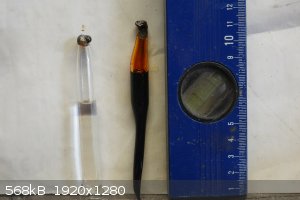
metalresearcher - 12-6-2022 at 08:07
After making Br2 I want to seal it in an ampoule. I have 10mm (wall thickness 1mm) borosilicate tubes which I can heat to weakening in a propane flame
and then squeeze together on one end. Then I heat the other end to narrow it and let it cool.
Then I first filled it with water to test using a pipette until about 3cm below the top and heated it again to soften it and glue it. But it did not
quite seal. Probably my propane flame was not hot enough. Now I used my welder, set it rather low (40 A), took two carbon rods and used the much
hotter electric arc to seal it which worked. Turning the water ampoule upside down did not reveal any leaks. For the sealing I used an extra
transparent acryl screen in case of an explosion due to overpressure, but that did not happen. The 'weld' was somewhat black due to embedded carbon
partciles, but it did seal.
Now I did the tricky part: using the arc with bromine in the ampoule. Gas mask on and screen between welding helmet masked face and arc. After three
times it was not completely sealed as some brown fumes were still appearing, but no droplets. Admitted, the bromine level is somewhat closer that the
water level in the ampoule, maybe too close ?
See picture with both ampoules.
How do you guys seal an ampoule ?

Oxy - 12-6-2022 at 10:10
You can buy pre-made ampoules, they are however not cheap (if you have no luck). This is the easiest route.
If you want to use test tubes - borosilicate glass might be not the easiest one for propane burner. I managed to do some glass work with that (boro
glass/propane burner) but I don't consider it as my best. You can buy test tubes made not from borosilicate glass which should help.
The tube should be really soft before you put any force. I start with pre-heating to avoid any cracking due to thermal shock. Once warmed I move the
tube to the hottest area of flame and rotate it to heat it equally. After some time the glass starts to weaken but it's too early to do anything. When
it becomes red and very soft - that's the time. I used to hold the tube in hand on one side (closed side) and tweezers on opened (as it's much more
close to the flame). When the tube is ready I move it out of the flame while stretching it gently until it closes. Then I put it to the rack where
it's cooling down. After few minutes it's cold and sealed.
Important thing to remember is to avoid any twisting of the molten glass because it might cause some tension and the tube may crack easily during
cooling down or later. It may end up badly depending on the substance and place of storage.
I made some ampoules from borosilicate tubes but it was not easy and I lost much more of them. It shouldn't be a problem with a higher temperature
setup.
Welder might work but I would not use that because of sparking and risk of fire or explosion. Even maybe an electric shock which doesn't look well
during any laboratory work (does not look well at all).
Herr Haber - 13-6-2022 at 06:34
I just called Laboratorium Discounter where I placed an order a couple of weeks ago for some chemicals (I have done almost zero chemistry in the past
year) and most importantly 144 10ml ampoules.
Yes, they are expensive: 123 Euros for the bunch. But after seing a couple of videos on Youtube I'm 100% convinced they'll be 100% easier to use and
seal than test tubes.
Seing how they are made, I'd feel more secure sealing a flammable in them than in a test tube.
I was of course also thinking about bromine but before I get to that I'll ampoule a bit of DCM and heat it to test the quality of my seals under
pressure.
I hope I'm better at that than at welding !
But if pre-made ampoules are too expensive as Oxy mentioned you can buy regular soda glass test tubes for cheap from China. At least you will only
have to seal one end 

